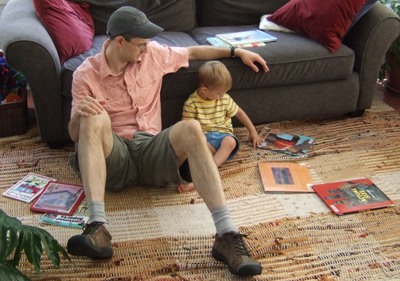While I probably qualify as a film buff, I’m not much of a movie-goer these days, and it’s especially rare for me to take in a blockbuster film on opening weekend. Rarer still when it’s a blockbuster adaptation of a book. Feeling the frenzied anticipation of next weekend’s BIG book release, though, I joined the crowd of cinephiles and wizard-wannabes at a Saturday night screening of Harry Potter and the Order of the Phoenix. My hope was that the film would be, like its predecessors, at least moderately entertaining and that (more importantly) it would refresh my memory as to the contents of Harry’s 5th adventure. I’m feeling a rather desperate need to cram for next weekend’s final exam and goodness knows I don’t have time to reread the Rowling canon.
As a refresher course, the film turned out to be a bit disappointing. Many of the book’s sideline plots were, well, sidelined (even more so than in previous films), no doubt in the interest of keeping the film to a reasonable length. There are a couple of benefits to this loss: Harry’s sniveling self-pity, a prominent and at times tiresome feature of this book, is kept to a minimum, and the plot zips along unencumbered by extraneous storylines. It was a bit odd, though, to watch a Harry Potter adventure in which Draco Malfoy appears only in passing and even Snape is given shockingly little screen time. Streamlining the story to this extent may also have been why it had less emotional impact for me than the last film. The death of a major character near the story’s end should have hit home (even though I knew it was coming), but instead I felt this person hadn’t been on screen long enough for me to have developed much attachment to them. What the film ultimately lacked for me was suspense. But the humor and visual effects more than made up for it.
Honestly? I don’t know when I’ve ever said this before, but the images in this movie are SO MUCH cooler (dare I say “better”?) than the images I had in my head while reading the book. The sets (both actual and computer-generated) were so rich with visual detail and so convincingly real that I wanted to laugh out loud with the sheer “completeness” of the scenery. Panoramic views of almost every sight in the film help complete the sense that you could be viewing something that actually exists in the real world. The images of Hogwarts (both inside and out) look good enough to have been stolen from actual castle footage. The Ministry of Magic realistically bustles with activity as wizards walk purposely to and fro beneath a several-stories-high poster of Cornelius Fudge. Rows of prophecies carefully balanced on Department of Mysteries shelves seem to go on forever. Kittens mew plaintively from decorative plates on the walls of Dolores Umbridge’s office, eliciting laughs from the audience each time the appeared. With the exception of the magical creatures who still look digitized (Grawp especially), I was completely taken in by this film’s special effects, and those around me appeared to be as well. The characters in Harry’s world seemed integrally connected to the scenery around them rather than pasted in front of it, making it that much easier to be swept up in their adventures, even for those of us who already knew exactly what those adventures would be.
Frustrated as I am with Warner Brothers at the moment, I must nevertheless admit that I thoroughly enjoyed the movie version of Harry Potter and the Order of the Phoenix. It was a unique thrill to see Harry’s world spring so vividly to life, in ways that even my over-active imagination couldn’t have conjured. The richness of the film’s story pales, of course, in comparison to that of the book, but the richness of its imagery certainly gives Harry’s fans plenty to talk about as we await our final opportunity to travel anew through the magical world of Rowling’s creation.







